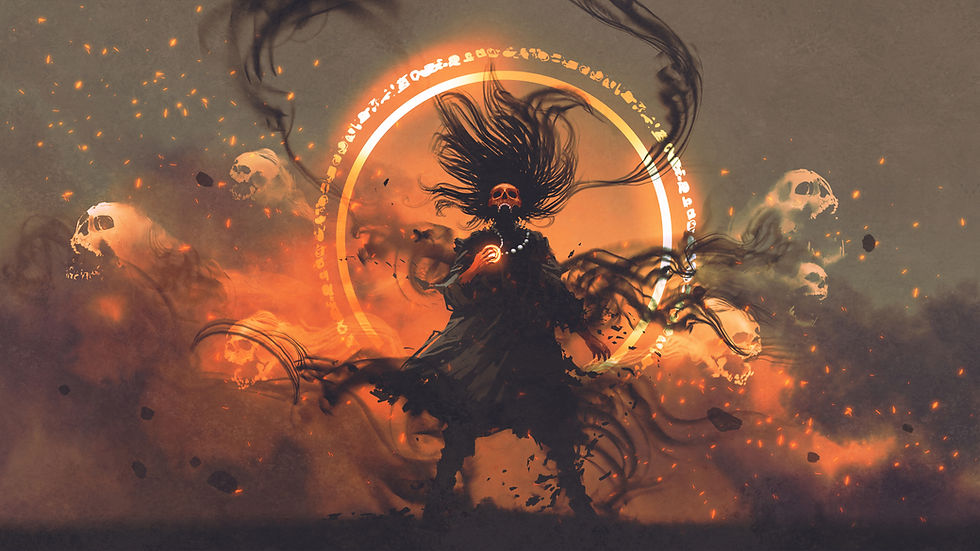Ninhursag - Great Mountain Mother
- Sylvia Rose

- Dec 24, 2023
- 4 min read
Updated: Dec 26, 2023
A mother goddess of ancient Mesopotamia, Ninhursag is one of the original seven dieties or 'those who decree', called the Anunnaki. She and her group are associated with human fate. Her earliest role is as a nurturing and fertility goddess.
See also:
She's the tutelary deity of several Sumerian monarchs and leaders of Lagash who consider themselves 'nourished by the milk of Ninhursag'. She's been called 'the true and great lady of heaven', 'Great Queen' and 'Lady of Birth'.
Read: Cult of the Fire God - Bronze Age Adventure New 2024
Her name means "Lady of the Sacred Mountain." The mountain is a sign of wonder, strength, longevity, divinity, hidden secrets of treasure or wisdom.
See also:
The mountain rises above the mortal world. She stands for security, stability, fertility and sometimes savagery, danger and death.
Read: Cult of the Fire God - Bronze Age Adventure New 2024
She exists in blazing fires and drifting fog. Connecting to the Underworld and the fecund womb she gives birth to bats, snakes, the great bear, fertile silt, precious gems and sparkling waters of the earth. The Mother Goddess can be represented by the mountain, or she can be the mountain herself.
See also:
Ninhursag becomes known as a goddess of fertility, mountains and rulers. She's the mother of about two dozen children including Ninurta, the epic warrior god.
Her consort is Shulpae (Šulpae), a Mesopotamian god with unsettling Underworld traits. His name translates to 'the youth shining forth' or 'the young one shining forth'. He's associated with Jupiter and certain diseases including bennu or benu (epilepsy), not to be confused with Benu the Heron God of Egypt.
See also:
According to a text from c. 8th century BCE, discovered in 2019, "the demon causing this disease is one of the most feared" in the world. Symptoms of bennu include seizures, loss of consciousness or sanity, and, in some cases, the patient bleats like a goat.
The theonym Lugaludda, meaning Lord of the Demons, can apply to Shulpae. As demons are believed to cause sickness, he is a powerful one. He's considered a namtar demon, a class of entities named after the sukkal of Erishkigal.
See also:
The demon is said to act by the command of the Moon God, Sin (Suen). This may have given rise to ideas of lunacy, or madness connected with the moon. At the same time, Shulpae is considered a divine warrior and deity of wild animals.
The name of Shulpae is found in texts as early as 2900 BCE. Although multiple temples to Shulpae are recorded, their locations are unknown.
See also:
This isn't surprising. Shulpae is a God but also a demon. As a rule, Mesopotamians don't worship demons. Demons are invoked. They have no temples. Many however are considered to have beneficial or protective aspects, such as the good and evil udug or gallu demons.
Some, like Namtar, are sukkals who must deal with the public. Others, like Pazuzu, can be invoked to counter the evil of a rival demon, such as Lamashtu. Incantations are available to invoke demons at home. Getting rid of one isn't always so easy.
See also:
Ninhursag is known as Nintir in her aspect as a birth goddess. Nintir can also be a separate goddess. Other appellations given to Ninhursag include 'midwife of the Gods', 'Mother of All Children' and 'Mother of the Gods'.
Read: Cult of the Fire God - Bronze Age Adventure New 2024
Like many other nature deities Ninhursag is originally a household goddess whose influence spreads through multiple levels of society. She has no specific cult center though may have had a temple at Kish. She's a birth goddess of human women and also livestock and wild animals.
See also:
Associated with mountains and fertility, throughout her long life she also becomes an Earth Goddess, given to rule all the lands. Her name Damgalnunna is invoked, ironically, to repel evil demons.
Ninhursaga and Nintur appear as variations of her name in incantations relating to childbirth. She's also said to accept offerings to cure bedwetting. Her healing role is prominent when she heals the god Enki in the myth Enki and Ninhursag.
See also:
She's listed as Dingirmah in the An = Anum, the premiere god list of the Mesopotamians, and stands at the head of a vast court. Her sukkal is Ekigara. a lesser known entity. Her entourage includes heralds, attendants and courtiers. One group is called her "bull lyres".
Ninhursag is synchronized with the Elamite goddess Kiririsha, the Mother of the Gods in Elam. Ninhursag is often shown seated on mountains. Her symbol is the Omega Ω. Her hair may be in an omega shape. She wears a flat crown without the tiers of horns.
See also:
An ancient door socket found at a mound by the Adaim River bears this inscription:
"Manistusu, king of Kis, builder of the temple of the goddess Ninhursaga in HA.A KI. Whoever removes this tablet, may Ninhursaga and Samas uproot his seed and destroy his progeny."
See also:












